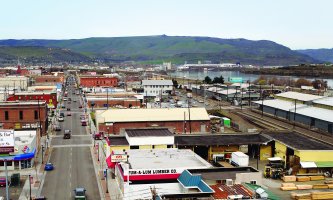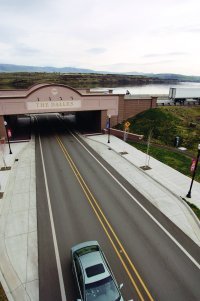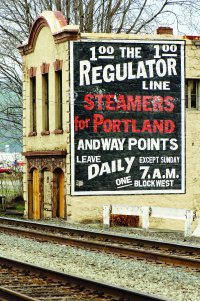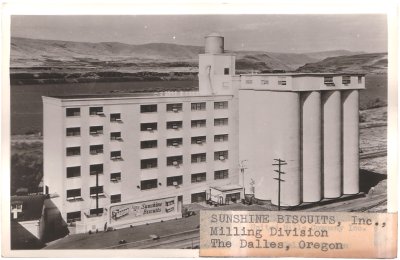 Depending on where you stand, the city of The Dalles presents very different sides. One is from above the city, at the Mid-Columbia Veterans Memorial at Sorosis Park.
Depending on where you stand, the city of The Dalles presents very different sides. One is from above the city, at the Mid-Columbia Veterans Memorial at Sorosis Park.
A river town’s resolve
The overnight success of The Dalles has taken decades, pushed by grit, vision, timing and hometown passion. Google? Yesterday’s news.
By Robin Doussard
Depending on where you stand, the city of The Dalles presents very different sides. One is from above the city, at the Mid-Columbia Veterans Memorial at Sorosis Park. From there, the town’s beauty is evident: Golden hills roll down to the Columbia River under clear blue skies; breathtaking vistas unfold for miles; the historic city center nestles close to the river. “Uniquely situated” is the mayor’s marketing line and, yes, you can see that from here: rail, highway, port, water, affordable land, sun; all fortuitously converging in the valley below, where the Oregon Trail ended and a town began 150 years ago.
 The highway underpass at Union Street is part of the city’s plans to reconnect the town to its river. The highway underpass at Union Street is part of the city’s plans to reconnect the town to its river. |
The view is not as lofty at river level. Retail sprawl and rough industrial land greet you as you enter the city on the highway. (“We kind of show our ass first,” says local businessman James Martin.) There are vacant downtown stores and lots, and housing stock that’s seen better days. At street level, you see a small town still recovering from big industry collapse, severe job loss and recession; a town still considered “distressed” because of its low incomes, high unemployment and poverty.
The story of any town is shades of gray, and The Dalles is no different, even including its bit of fame and glory with the heralded arrival of Google. The California-based Internet search company sparked international attention, heated speculation and high hopes when its interest in The Dalles became public in 2005.
While Google gave other businesses a reason to consider The Dalles and gets credit for helping boost real estate (local agents peg the median home price around $178,000, and there is substantial new home construction, with 200 starts in 2006), it has not paved the streets with gold. Several years of strong national and state economies have been more important in helping cities like The Dalles regain their fiscal footing.
In fact, the Google presence, a server facility at the Port of The Dalles, is hard to detect, which is not surprising given the secretive company culture and the confidentiality required of local officials during negotiations. To date, Google says it has hired about 20 local workers out of a planned workforce of 50-100. No one from Google belongs to the chamber, and its plant is a small fortress. No friendly open-house parties there.
“Google gave us a nice buzz, but it hasn’t done what we thought it would,” says Gary Grossman, a longtime broadcaster with hints of late-night smoothness still in his voice. Grossman is a businessman, he’s president of Columbia Gorge Broadcasters, who moved here about four years ago and is deeply involved in the community as president of the chamber of commerce. He is affectionate yet knowing as he assesses the recent resurgence of the town.
“It increased our property values and our tax base, but it didn’t make us wealthy,” he adds. “Now we’re settling down to reality. There’s opportunity, but it’s not like Bend. It’s not the tidal wave that was expected. But that gives us time to plan.”
The dogs have barked (“The town is changing, and fast,” declared an Oregonian story last summer) and the caravan has moved on. The city is back to taking care of business, charting through the gray waters a recovery course that started several decades ago.
PLANNING IS THE MANTRA HERE. It came out of the depths of the aluminum industry collapse, and Dan Durow, the city’s director of community development, has been in the thick of it for 30 years.
 The Granada Theatre is one of the downtown’s many historical gems. |
After the Martin Marietta aluminum plants closed in 1984, taking 1,200 jobs, there was a “rebirth,” says Durow. (Northwest Aluminum later bought the plants and reopened them in the late 1980s. They closed in 2000, and 1,000 jobs again were lost.) It started with a community that agreed “over and over to tax itself despite our poverty and income rates.” An urban renewal agency and enterprise zone were created, a master plan for the riverfront was conceived, and plans to diversify the economy were made.
“It might appear that we were an overnight success,” Durow says, “but it has been 20 years. Google was the icing on the cake. We were already in an economic turnaround.”
“We knew our time was going to come again,” says native son and longtime Mayor Robb Van Cleave. He and his fellow business and civic leaders cite many accomplishments in the past few years, progress that they credit to effective civic teamwork, community optimism, the willingness of residents to dig into their own pockets and, without a doubt, being uniquely situated.
The list is notable. To date, there’s been an $80 million investment in the downtown that includes an underpass at Union Street to reconnect the town to its river heritage, which was amputated when Interstate 84 opened in the early 1960s and sliced through the town. There’s also a fiber-optic network that loops the city; a new middle school, post office and veterans home; significant port development; and a $7 million renovation of the Commodore Hotel, built in 1906 as a Masonic lodge and now a mixed-use building.
On the horizon is the $150 million Lone Pine Village, a mixed-used waterfront community set to break ground in June; a $26 million expansion of Columbia Gorge Community College to be completed in 2008; new owners and plans for the historic Granada Theatre; and, after 17 years, finishing the riverfront hiking and biking trail.
IMPROVEMENTS TO THE PORT were a priority, and while that isn’t glamorous, it is nuts-and-bolts infrastructure investment that pays off. In the past decade, 500 jobs have been created in the port district alone, from companies such as window and door parts manufacturer Homeshield and Round Top Windows, according to port executive director Andrea Klaas. Winning Google took a full-court press by many in the community, but the readiness of the port’s industrial land, and cheap hydropower, was critical. Future port plans include opening up 400 acres for development by pulling down the shuttered Northwest Aluminum plant.
 The city wants to restore the Gitchell Building, which was built in 1867and is the oldest commercial structure in The Dalles. |
The mayor wants to “turn the town back around to face the river,” and projects such as the Union Street underpass, and another planned at Washington Street, are designed to create a gateway into the city from the Columbia. Important to this is the plan for a new cruise dock that will cost $2.3 million and allow the big ships to come up river with their dollar-laden tourists. City manager Nolan Young says that $250,000 in local money has been committed, and the search is on for federal funds for the rest. In the meantime, there are plans for a temporary dock to be installed this summer.
There are other dreams: redeveloping the old flour mill; improving the city’s look through a public arts project; making social responsibility a formal city goal; creating a golf course on the airport property in Dallesport, Wash.; various wind, dam and hydro ideas. Leaders are continuing to focus on diversifying the business base beyond its largest employers (Mid-Columbia Medical Center and agriculture are two) to help safeguard against the historic boom-and-bust of the region.
They also cite a long list of problems that they, like many small Oregon towns, still struggle against: meth, aging schools, sun-setting timber payments (which comprise 65% of the county’s budget), a shortage of health-care workers, affordable housing and industrial land. The aluminum industry’s final collapse in 2000 slid into the 2001-2003 recession and pushed Wasco County’s annual unemployment rate to a high of 9.7% for 2003. In light of this, the stable population is interesting: In 2000, it was at 12,175; it currently stands at 12,600. There was neither a huge exodus during the downturn nor or a huge influx post-Google.
Though Wasco County’s jobless rate has been consistently higher than the state average, the gap has narrowed in the past four years. State figures show that county unemployment has steadily dropped since 2003 to an annual average of 5.6% for 2006, only a few ticks higher than the state average of 5.4%. And employment in all the key industries, except manufacturing, has climbed in the past three years.
But 2004 state figures, the latest available, show average incomes in Wasco County are around $25,000 per year, about $8,000 lower than the state average, and approximately 14% of the county living in poverty.
“Even though we’ve made all these gains,” notes Durow, “we’re still a severely distressed county.”
A TOUR OF DOWNTOWN with Gary Grossman and Nolan Young puts the future in the windshield. With Young in the back seat and Grossman at the wheel, they use the nose of the car to outline the vision.
The city is focused on revitalizing its downtown, a priority shared by communities from Astoria to Baker City that understand the importance of their historic cores to a thriving local economy. The Dalles’ downtown is decidedly working-class, with its bowling alley, discount mattress store and hard-by-the-railroad location, but more real than some of its overpriced, over-boutiqued brethren. It’s still a struggling mix of restored buildings such as the 1890 Italianate beauty that houses Sigman’s Flowers, and dilapidated eyesores.
 Retail sprawl and industrial land is the view when entering The Dalles. Retail sprawl and industrial land is the view when entering The Dalles. |
Young ticks off some of the projects in the city’s strategic plan: the second highway underpass; the completion of the riverfront trail; restoration of the Gitchell Building, which was built in 1867 as a drug store and is considered the oldest commercial building in The Dalles. The city also wants to upgrade the look of First, Third and Fourth streets in an $8 million project to fix sidewalks and drainage, and install streetlights and trees.
All the projects are in various stages of finding funding. The Dalles is considered to have one of the most effective lobbying groups in the state with its Community Outreach Team, lauded last year by the Oregon Economic Development Association. It’s a collaborative mix of civic, business and government leaders whose strategy is “we never ask D.C. for the first dollar,” says Van Cleave. The city manager estimates that in the past seven years, the team has snagged $6 million in federal funding.
The windshield tour pulls up at the old Sunshine Biscuit Co. flour mill at the east end of town, which the Urban Renewal Agency has optioned to local developer James Martin. Martin wants to create a $24.4 million complex containing a plaza, condos, offices, retail space and a boutique winery. The city is seeking $1.8 million in federal funding to redo the intersection at Highway 30 and Brewery Grade, where the flour mill sits.
Martin is fifth-generation (raising the sixth) and moved back to his family’s cherry farm 10 years ago from Portland. He now leases out his cherry operation and has diversified into wine making to survive. He sees a different spirit in town lately, one where “people will take risks now. We’re not downtrodden anymore.” He says more young entrepreneurs are moving in, and the community is getting cleaned up.
Martin is disappointed by the intersection delay, but says he’s moving ahead with developing of a portion of the project that doesn’t rely on it, a $2.1 million plaza.
“It’s a long, slow process,” he says, “but I’m going to be here for the rest of my life.”
IT’S THIS KIND OF PEOPLE CAPITAL that drives any community’s development and The Dalles has its share. Gary Grossman sums it up: “It’s a blend of founding fathers, kids who have come back and those who have found it for the quality of life.”
 Redevelopment plans for the old Sunshine Biscuit flour mill include a boutique winery, artisan plaza, condos, offices and retail space. |
Another prodigal son is Keef Morgan. A Dalles native, the 31-year-old Morgan returned three years ago after leaving town post high school to travel the world building ships. He now sells real estate alongside his dad, and says business has been hopping.
Morgan sees a lot of people in his age group coming to The Dalles because “it’s a really good place to live.” He’s bought a home and takes full advantage of the recreation just outside his door.
He also chairs the downtown business group. While he’s impatient with some of the businesses — “They need to stay open on the weekends; they need to clean up their store fronts” — he is clearly one of James Martin’s young entrepreneurs who have come back to change the town.
Just arrived and also carrying an entrepreneurial suitcase is Lee Weinstein. At 47, after 15 years as a Nike executive, Weinstein this spring bagged it and moved to the 80 acres he and his wife bought just outside of town.
“We drew a two-hour circle around Portland to see where we might live,” says Weinstein, a native Oregonian. They discovered the beauty of The Dalles, and the game was over.
He has a satellite dish and plans to run a public relations consulting business from his house. Weinstein also volunteers with the chamber, chairing its marketing committee and helped birth the “uniquely situated” line, but says they’re still working on what truly captures the essence of The Dalles. (He also suggests “300 days of sunshine and open for business.”)
“It’s a town that’s really on the offense,” he says, admiring his new home. “There’s been a lot of hard work that’s gone into the town.”
Weinstein then drops another slogan off the cuff, but maybe not so far off the mark for a town that has weathered 150 years of boom and bust.
“The Dalles,” says Weinstein, “is the little town that could.”
Have an opinion? E-mail [email protected]


